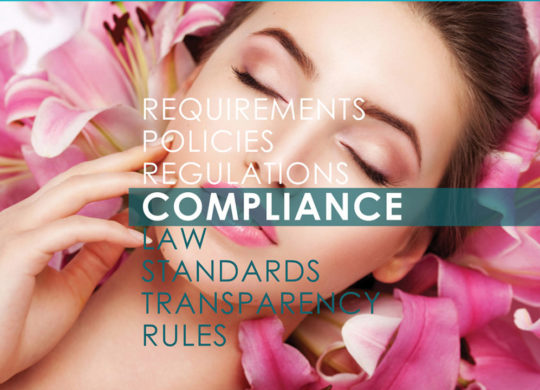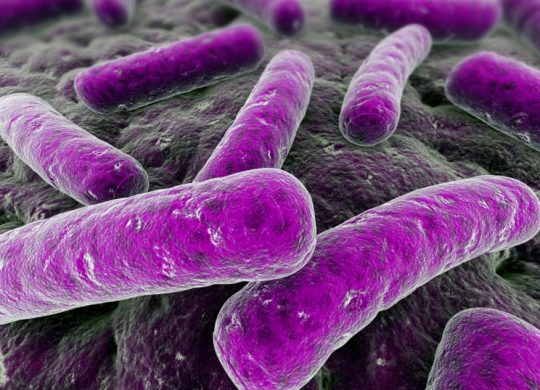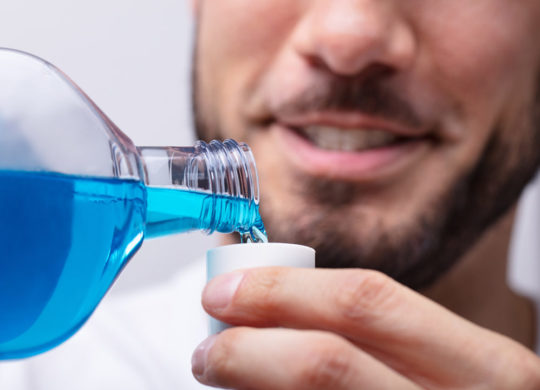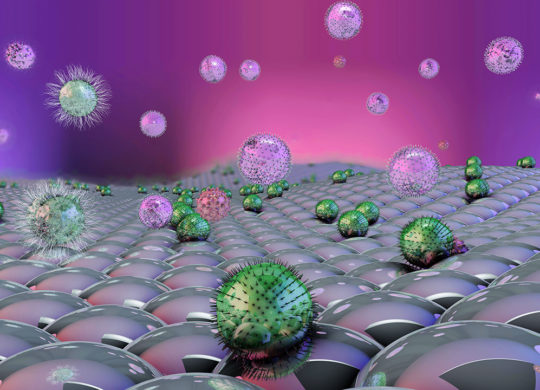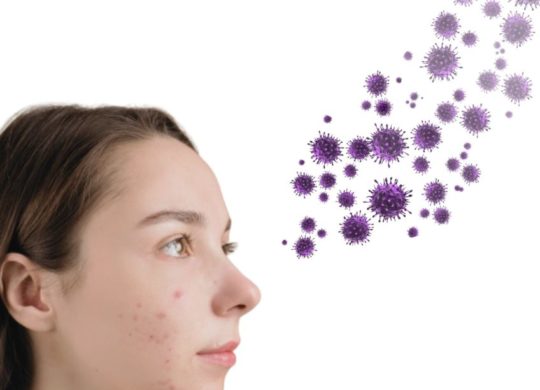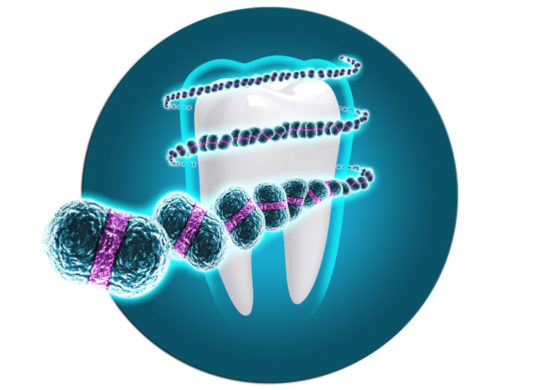Preface
Because of COVID-19 we discover that nature is not always our friend. Just as we were never the friend of nature. Unfortunately, I have only knowledge about cosmetic solutions, and I can’t help with any advices to fight against the virus COVID-19. A virus that unmasked our civilization. But I can help with the next problems that will soon make our lives difficult and will hinder our protection against the virus. This paper provides you genuinely vital and concrete advices that goes beyond the explanation of our ingredients.
Introduction
“Wash your hands with soap and running water when hands are visibly dirty. If your hands are not visibly dirty, frequently clean them by using alcohol-based hand rub or soap and water”. This is literally what the WHO advices us (1). To protect us from the virus, this is without any doubt the best strategy. Unfortunately, this life saving advice has 2 side effects. These side effects will dominate most of our lives, even long after the virus has faded away in oblivion.
Hand sanitizers and hand soaps are not developed for frequent use. They invade our skin, destroy the complete skin’s protective power and leave it behind as a heavily bombed city. The goal should become to clean and disinfectant without diminishing the protective resources offered by the skin.
The tsunami of hand washes
The absolute most vital function of the skin is to protect our body from the hostile environment. Thanks to the ingenious skin barrier the deadly enemies, such as UV-light and germs do not enter the body. To construct a bullet-proof shield, the skin uses dead skin cells as stones of keratin, bricked together with a sophisticated cement (Fig1). This sophisticated cement is a complex mixture of protective water loving and oil loving substances as described in Table 1 (2)
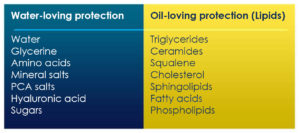
Table. 1 The skin barrier components.
The water-soluble protection is locked safely in a laminar structure formed by the oil soluble components. If one of these substances is missing, the barrier weakens.
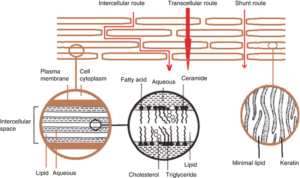
Fig. 1. Protective skin barrier.
A hand wash is loaded with surfactants. They destroy indeed the membrane of micro-organisms, such as viruses (hence the advice of the WHO). Surfactants disperse sticky dirt from our skin into the water. Unfortunately, in a few seconds all the protective and life-precious lipids from the skin’s cement are driven out of the skin. The water-loving components are now unlocked from their laminar shield and are also washed away forever.
Yes, the potential virus on the skin is killed, but so is our skin barrier. The skin is completely deprived from its protective task. When hand washes are only used occasionally, the skin can recover. However, if hand washes are frequently and intensively used, the skin has no chance anymore to rebuild the skin barrier.
A skin that has lost his barrier feels itchy, uncomfortably dry and becomes red. In a further stage, the skin starts to hurt, becomes rough, scaly, cracks open and bleeds. Skin pathogens such as Candida albicans (3) and Staphylococcus aureus (4) colonizes successfully this rough skin. These micro-organisms eat the living skin away and exhaust our immune system. Finally, the strong, beautiful and protective organ that the skin once was, fades away into a helpless eczema or repulsive dermatitis state. Eczema and dermatitis are not only painful, but also difficult to cure. Even when the skin seemed cured, it might and will reappear for the rest of one’s life easily. Hands suffering from eczema can not be washed and disinfected any more… How to protect these hands further from the virus?
The horror gets worse, the germs infecting the skin is one thing, but a breached skin will allow germs entering the blood stream. Infections can now go beyond the skin and further into the body.
The sanitizer genocide
The mighty skin barrier is on its turn protected by an ingenious community of microorganisms. Every single micro-organism that doesn’t belong to the skin is efficiently killed by a cocktail of organic acid or an endless collection of antibiotics and enzymes (5). Many resident members of the skin microbiota produce strong anti-viral substances. Some of these substances do not merely kill viruses, but also increase our resistance against viruses(6, 7, 8, 9, 10). There is unfortunately no information at the moment if COVID-19 is killed by the skin microbiota.
Thanks to this antimicrobial shield germs have limited success in invading our skin and body.
The ethanol from sanitizers doesn’t care if the skin has this ingenious antiviral/antimicrobial shield. Ethanol makes no distinction between COVID-19, pathogens and protective microorganism. It kills everything: a total genocide.
The destructive effect of ethanol extends even further than merely dismantling our anti-germ shield. Ethanol also removes the complete skin’s oil-loving cement and thus destroys our complete skin barrier.
An intensive use of hand sanitizers leads to a dramatic increased risk of Staphylococcus aureus infections (11). Depriving the skin from its ingenious anti-microbial shield will overload our immune system an will lead to infections and sickness. The body becomes weaker. Our resistance against COVID-19 is then compromised.
The frequent use of the mass destructive hand sanitizers combined with the invasive hand wash is indeed a powerful weapon to combat COVID-19. The strategy is almost perfect if the use is intended for a short period like 1, maximum 2 weeks. On the long term, it annihilates all the gifts of nature that defend us against skin infections. Actually, this strategy works opposite and promotes infections in the long run.
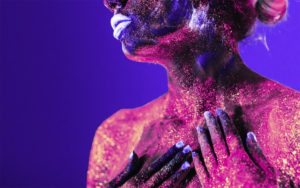
Concrete strategy to protect us from germs
Protecting ourselves against germs, without destroying our barrier is the long-term strategy.
This can be obtained by:
• Making milder handwashes
• Making milder hand sanitizers
• Developing creams that truly repairs the skin barrier
• Developing creams that efficiently supports our ingenious anti-microbial barrier
Hand wash with mild surfactants
A first strategy could be to diminish the skin destruction. The surfactants that limit skin’s destruction are listed in Table2. Here the surfactants are classified from the mildest towards harsh surfactants that need to be avoided at any time:
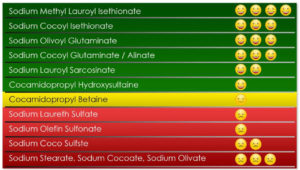
Table2: Classification of surfactant according to their irritation potential.
Hand wash with skin repair
Choosing a mild surfactant is a good start, but it merely delays the skin damage. The precious skin lipids will still disappear. Therefore, it is additionally important that the hand wash restores the skin. BIODINE V can repair the skin through a hand wash. BIODINE V is a vegetable blend that mimics ALL the skin lipids (Fig.2). Precisely the lipids we lost while using soap are restored with BIODINE V.
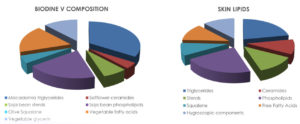
Figure 2. Comparison between composition skin lipids and BIODINE V.
A hand wash containing 0.5% BIODINE V improves the hydration of the skin with 100%, which is an unseen result. The hydration last more than 8h long (Figure 3). It is important that ALL lipids are restored in order to support again the skin barrier. Adding only glycerine, a vegetable oil or butter provides indeed more comfort, but no substantial skin repair.
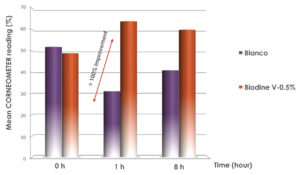
Figure 3. Hydration BIODINE V in Body wash
A hand wash that repairs the skin, supports the protection of the skin against germs.
Prebiotic selective hand sanitizers
It is not possible to replace the destructive ethanol or isopropanol in the war against COVID-19. When alcohol is combined with a prebiotic such as preBIULIN FOS (INCI: Inulin, Fructose):
- The skin microbiota becomes twice stronger and recovers faster, than with alcohol alone (Figure 4).
The faster recovery forms quicker and more efficiently an impenetrable anti-microbial shield.
Hence, the alcohol becomes less destructive to our skin. - The ethanol kills more selectively and therefor more efficiently. Mainly unwanted germs are
reduced (Figure 5). - As preBIULIN FOS is a smooth skin conditioning agent, the hand sanitizer will feel more comfortable.
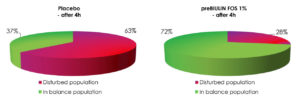
Figure 4: The influence of alcohol and the balancing influence of preBIULIN FOS.
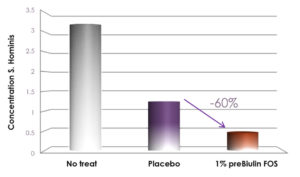
Figure 5: The influence of preBIULIN FOS on the anti-microbial effect of ethanol.
Prebiotics are bio-selective food. Prebiotics support the protective micro-organisms on our skin, but does not support fungi, viruses and pathogenic germs.
Ideal Repair cream
Active ingredients
It is important to use a hand cream after intensively cleaning the hands. A moisturizing cream that merely keeps the water in the skin is far from enough. These creams use ingredients that offer mainly instant comfort and greasiness, but no repair and protection on the long term:
- Paraffinum liquidum
- Petrolatum
- Beeswax
- Vegetable butters and oils
- Glycerin
- Hyaluronic acid
- Hydrolysed proteins
These ingredients are only a part of the solution. To repair substantially the skin, ALL the lost skin lipids needs to be added. Our product BIODINE V fixes this problem as it contains all the necessary protective lipids. A dosage of 2.5% repairs the skin spectacularly (Figure 6).
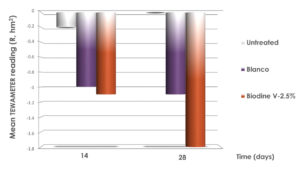
Figure 6: The remarkable influence of BIODINE V on TEWL of a damaged skin.
Preservative
The weak link in each emulsion is the preservative system. Cosmetic preservative used in the legally approved dosage are safe. However cosmetic formulations are designed for a 100% intact skin. An intensively washed/sanitized skin suffers from a breached skin barrier. Preservatives that normally do not harm the skin, irritates a stressed skin. Therefore, Caprylyl glycol, Benzyl alcohol and organic acids should be avoided as much as possible.
Preservatives still have another destructive effect. They kill our skin microbiota, our last resort in protecting us from germs. The preservatives will further weaken the already stressed microbial barrier. The use of preBIULIN AGA (high molecular weight inulin) is necessary to support the microbial barrier in these challenging times. preBIULIN AGA feeds only the protective microbial barrier. preBIULIN AGA makes the skin microbiota 5 times stronger against all this sanitizing, preservative and hygienic violence. Thanks to presence of min 1.5% preBIULIN AGA a cream supports our natural protection against germs.
Emulsifier
Each cream needs an emulsifier to keep the water and the oil together. It’s the necessary evil. Classic emulsifiers remove further some of the protective skin lipids. Under normal circumstances this is not a real issue. On a skin tormented by hand washes and hand sanitizers this might cause additional stress.
Lecithin
One of the best solutions is the use of lecithin to make mild oil-in-water-emulsions. To develop with these kind of skin identical emulsifiers is a real challenge. A challenge that can be overcome by combining the lecithin with INUTEC SL1.
INUTEC SL1- Inulin Lauryl Carbamate
This natural polymeric emulsifier is not able to destroy the skin lipids. Emulsions based on Inutec SL1 are one of the safest solutions.
Glutamates
Emulsifiers based on glutamic acid have a slight influence on the skin lipids but are still very mild.
NEOCARE P3R
To obtain a fast repair of the skin lipids it is advisable to use a water-in-oil emulsion based on the hydrating emulsifier Neocare P3R. These emulsions have a 24h moisturizing effect and are therefore the perfect base for a hand treatment.
Conclusion
The one-sided approach of using ethanol and soap is not a solution for the long term as this leads to a slow suicide of the skin physical barrier and anti-microbial shield. Prebiotics are a safe and efficient solutions in hand sanitizers and hand soaps to keep on killing the virus, but not our protective anti-microbial shield.
PreBIULIN FOS is an excellent partner to make hand washes and hand sanitizers milder for the
protective skin microbiota.
The use of a repairing cream containing the right skin lipids (BIODINE V) after washing or sanitizing the hands is necessary to keep the skin intact. The use of high molecular weight Inulin (preBIULIN AGA) is necessary to undo the damaging effect of preservatives.

Contact US
GOBIOTICS BV
Jac Jansenweg 7
4631 SL Hoogerheide
The Netherlands
